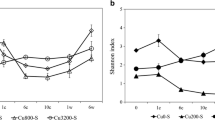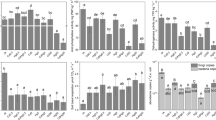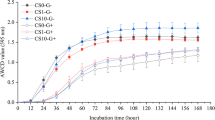Abstract
To improve the prediction of essential ecosystem functioning under future environmental disturbances, it is of significance to identify responses of soil microorganisms to environmental stresses. In this study, we collected polluted soil samples from field plots with eight copper levels ranging from 0 to 3,200 mg Cu kg−1 soil. Then, the soils with 0 and 3,200 mg Cu kg−1 were selected to construct a microcosm experiment. Four treatments were set up including Cu0-C and Cu3200-C without further Cu addition, and Cu0-A and Cu3200-A with addition of 57.5 mg Cu kg−1 soil. We measured substrate-induced respiration (SIR) and potential nitrification rate (PNR). Furthermore, the abundance of bacterial, archaeal 16S rRNA genes, ammonia-oxidizing bacteria and archaea amoA genes were determined through quantitative PCR. The soil microbial communities were investigated by terminal restriction fragment length polymorphism (T-RFLP). For the field samples, the SIR and PNR as well as the abundance of soil microorganisms varied significantly between eight copper levels. Soil microbial communities highly differed between the low and high copper stress. In the microcosm experiment, the PNR and SIR both recovered while the abundance of soil microorganisms varied irregularly during the 90-day incubation. The differences of microbial communities measured by pairwise Bray–Curtis dissimilarities between Cu0-A and Cu0-C on day 0 were significantly higher after subsequent stress than before. However, the differences of microbial communities between Cu3200-A and Cu3200-C on day 0 changed little between after subsequent stress and before. Therefore, initial copper stress could increase the resistance of soil microorganisms to subsequent copper stress.






Similar content being viewed by others
References
Rykiel EJ (1985) Towards a definition of ecological disturbance. Aust J Ecol 10:361–365
Luo WQ, Chen JH, Yuan JG (1999) The mechanism of copper tolerance. Prog Biotechnol 19:22–27 (in Chinese)
Bolan NS, Adriano DC, Mahimairaja S (2004) Distribution and bioavailability of trace elements in livestock and poultry manure by-products. Environ Sci Technol 34:291–338
Komarek M, Cadkova E, Chrastny V, Bordas F, Bollinger JC (2010) Contamination of vineyard soils with fungicides: a review of environmental and toxicological aspects. Environ Int 36:138–151
Wightwick A, Mollah M, Partington D, Allinson G (2008) Copper fungicide residues in Australian vineyard soils. J Agric Food Chem 56:2457–2464
Chander K, Brookes PC (1991) Effects of heavy metals from past applications of sewage sludge on microbial biomass and organic matter accumulation in a sandy loam and silty loam U.K. soil. Soil Biol Biochem 23:927–932
Wang YP, Shi JY, Wang H, Lin Q, Chen XC, Chen YX (2007) The influence of soil heavy metals pollution on soil microbial biomass, enzyme activity, and community composition near a copper smelter. Ecotoxicol Environ Saf 67:75–81
Wrage N, Velthof GL, van Beusichem ML, Oenema O (2001) Role of nitrifier denitrification in the production of nitrous oxide. Soil Biol Biochem 33:1723–1732
De Boer W, Kowalchuk GA (2001) Nitrification in acid soils: micro-organisms and mechanisms. Soil Biol Biochem 33:853–866
Könneke M, Bernhard AE, de la Torre JR, Walker CB, Waterbury JB, Stahl DA (2005) Isolation of an autotrophic ammonia-oxidizing marine archaeon. Nature 437:543–546
Chang YJ, Hussain A, Stephen JR, Mullen MD, White DC, Peacock A (2001) Impact of herbicides on the abundance and structure of indigenous beta-subgroup ammonia-oxidizer communities in soil microcosms. Environ Toxicol Chem 20:2462–2468
Oved T, Shaviv A, Goldrath T, Mandelbaum RT, Minz D (2001) Influence of effluent irrigation on community composition and function of ammonia-oxidizing bacteria in soil. Appl Environ Microbiol 67:3426–3433
Ying JY, Zhang LM, He JZ (2010) Putative ammonia-oxidizing bacteria and archaea in an acidic red soil with different land utilization patterns. Environ Microbiol Rep 2:304–312
Folke C, Carpenter S, Walker B, Scheffer M, Elmqvist T, Gunderson L, Holling CS (2004) Regime shifts, resilience, and biodiversity in ecosystem management. Annu Rev Ecol Evol Syst 35:557–581. doi:10.1146/annurev.ecolsys.35.021103.105711
Pimm SL (1984) The complexity and stability of ecosystems. Nature 307:321–326
Macdonald CA, Clark IM, Zhao FJ, Hirsch PR, Singh BK, McGrath SP (2011) Long-term impacts of zinc and copper enriched sewage sludge additions on bacterial, archaeal and fungal communities in arable and grassland soils. Soil Biol Biochem 43:932–941
Lejon DPH, Martins JMF, Leveque J, Spadini L, Pascault N, Landry D, Milloux MJ, Nowak V, Chaussod R, Ranjard L (2008) Copper dynamics and impact on microbial communities in soils of variable organic status. Environ Sci Technol 42:2819–2825
Philippot L, Cregut M, Cheneby D, Bressan M, Dequiet S, Martin-Laurent F, Ranjard L, Lemanceau P (2008) Effect of primary mild stresses on resilience and resistance of nitrate reducer community to a subsequent severe stress. FEMS Microbiol Lett 285:51–57
Tobor-Kaplon MA, Bloem J, Romkens PFAM, De Ruiter PC (2006) Functional stability of microbial communities in contaminated soils near a zinc smelter (Budel, The Netherlands). Ecotoxicology 15:187–197
Mertens J, Springael D, De Troyer I, Cheyns K, Wattiau P, Smolders E (2006) Long-term exposure to elevated zinc concentrations induced structural changes and zinc tolerance of the nitrifying community in soil. Environ Microbiol 8:2170–2178
Kurola J, Salkinoja-Salonen M, Aarnio T, Hultman J, Romantschuk M (2005) Activity, diversity and population size of ammonia-oxidising bacteria in oil-contaminated land farming soil. FEMS Microbiol Ecol 250:33–38
He JZ, Shen JP, Zhang LM, Zhu YG, Zheng YM, Xu MG, Di HJ (2007) Quantitative analyses of the abundance and composition of ammonia-oxidizing bacteria and ammonia-oxidizing archaea of a Chinese upland red soil under long-term fertilization practices. Environ Microbiol 9:2364–2374
Soil quality — Determination of abundance and activity of soil microflora using respiration curves. ISO, 17155:2002
Suzuki MT, Taylor LT, DeLong EF (2000) Quantitative analysis of small-subunit rRNA genes in mixed microbial populations via 5’-nuclease assays. Appl Environ Microbiol 66:4605–4614
Cao P, Zhang LM, Shen JP, Zheng YM, Di HJ, He JZ (2011) Distribution and diversity of archaeal communities in selected Chinese soils. FEMS Microbiol Ecol 80:146–158
Kemnitz D, Kolb S, Conrad R (2007) High abundance of Crenarchaeota in a temperate acidic forest soil. FEMS Microbiol Ecol 60:442–448
Francis CA, Roberts KJ, Beman JM, Santoro AE, Oakley BB (2005) Ubiquity and diversity of ammonia-oxidizing archaea in water columns and sediments of the ocean. Proc Natl Acad Sci U S A 102:14683–14688
Zhang LM, Hu HW, Shen JP, He JZ (2012) Ammonia-oxidizing archaea have more important role than ammonia-oxidizing bacteria in ammonia oxidation of strongly acidic soils. ISME J 6:1032–1045
Rotthauwe JH, Witzel KP, Liesack W (1997) The ammonia monooxygenase structural gene amoA as a functional marker: molecular fine-scale analysis of natural ammonia-oxidizing populations. Appl Environ Microbiol 63:4704–4712
Yuan H, Ge T, Wu X, Liu S, Tong C, Qin H, Wu M, Wei W, Wu J (2012) Long-term field fertilization alters the diversity of autotrophic bacteria based on the ribulose-1,5-biphosphate carboxylase/oxygenase (RubisCO) large-subunit genes in paddy soil. Appl Microbiol Biol 95:1061–1071
Tamura K, Dudley J, Nei M, Kumar S (2007) MEGA4: Molecular Evolutionary Genetics Analysis (MEGA) software version 4.0. Mol Biol Evol 24:1596–1599
Caporaso JG, Kuczynski J, Stombaugh J et al (2010) QIIME allows analysis of high-throughput community sequencing data. Nat Methods 7:335–336
Shade A, Read JS, Welkie DG, Kratz TK, Wu CH, McMahon KD (2011) Resistance, resilience and recovery: aquatic bacterial dynamics after water column disturbance. Environ Microbiol 13:2752–2767
Jiménez MA, Jaksic FM, Armesto JJ, Gaxiola A, Meserve PL, Kelt DA, Gutiérrez JR (2011) Extreme climatic events change the dynamics and invisibility of semi-arid annual plant communities. Ecol Lett 14:1227–1235
Gołębiewski M, Deja-Sikora E, Cichosz M, Tretyn A, Wróbel B (2014) 16S rDNA pyrosequencing analysis of bacterial community in heavy metals polluted soils. Microb Ecol. doi:10.1007/s00248-013-0344-7
Singh BK, Quince C, Macdonald CA, Khachane A, Thomas N, Abu Al-Soud W, Sørensen SJ, He ZL, White D, Sinclair A, Crooks B, Zhou JZ, Campbell CD (2014) Loss of microbial diversity in soils is coincident with reductions in some specialized functions. Environ Microbiol. doi:10.1111/1462-2920.12353
Allison SD, Martiny JBH (2008) Resistance, resilience, and redundancy in microbial communities. Proc Natl Acad Sci U S A 105:11512–11519
Kristian KB, Rasmus JNF, Peter EH, Ole N (2010) Development of pollution-induced community tolerance is linked to structural and functional resilience of a soil bacterial community following a five-year field exposure to copper. Soil Biol Biochem 42:748–757
Demoling AL, Baath E (2008) Use of pollution-induced community tolerance (PICT) of the bacterial community to detect phenol toxicity in soil. Environ Toxicol Chem 27:344–350
Martinez RJ, Wang Y, Raimondo MA, Coombs JM, Barkay T, Sobecky PA (2006) Horizontal gene transfer of PIB-type ATPases among bacteria isolated from radionuclide- and metal-contaminated subsurface soils. Appl Environ Microbiol 72:3111–3118
Thomas CM, Nielsen KM (2005) Mechanisms of, and barriers to, horizontal gene transfer between bacteria. Nat Rev Microbiol 3:711–721
Ramos JL, Duque E, Gallegos MT, Godoy P, Ramos-Gonzalez MI, Rojas A, Teran W, Segura A (2002) Mechanisms of solvent tolerance in gram-negative bacteria. Annu Rev Microbiol 56:743–768
Hemme CL, Deng Y, Gentry TJ et al (2010) Metagenomic insights into evolution of a heavy metal contaminated groundwater microbial community. ISME J 4:660–672
Liu YR, Zheng YM, Shen JP, Zhang LM, He JZ (2010) Effects of mercury on the activity and community composition of soil ammonia oxidizers. Environ Sci Pollut Res 17:1237–1244
Bissett A, Brown MV, Siciliano SD, Thrall PH (2013) Microbial community response to anthropogenically induced environmental change: towards a systems approach. Ecol Lett 16:128–139
Wohl DL, Arora S, Gladstone JR (2004) Functional redundancy supports biodiversity and ecosystem function in a closed and constant environment. Ecology 85:1534–1540
Langenheder S, Lindström ES, Tranvik LJ (2005) Weak coupling between community composition and functioning of aquatic bacteria. Limnol Oceanogr 50:957–967
Comte J, del Giorgio PA (2010) Linking the patterns of change in composition and function in bacterioplankton successions along environmental gradients. Ecology 91:1466–1476
Mertens J, Broos K, Wakelin SA, Kowalchuk GA, Springael D, Smolders E (2009) Bacteria, not archaea, restore nitrification in a zinc contaminated soil. ISME J 3:916–923
Barberan A, Bates ST, Casomayor EO, Fierer N (2011) Using network analysis to explore co-occurrence patterns in soil microbial communities. ISME J 6:343–351
Burke C, Steinberg P, Rusch D, Kjelleberg S, Thomas T (2011) Bacterial community assembly based on functional genes rather than species. Proc Natl Acad Sci U S A 108:14288–14293
Margesin R, Plaza GA, Kasenbacher S (2011) Characterization of bacterial communities at heavy metal contaminated sites. Chemosphere 82:1583–1588
Chaer G, Fernandes M, Myrold D, Bottomley P (2009) Comparative resistance and resilience of soil microbial communities and enzyme activities in adjacent native forest and agricultural soils. Microb Ecol 58:414–424
Berga M, Szekely AJ, Langenheder S (2012) Effects of disturbance intensity and frequency on bacterial community composition and function. PLoS ONE 7:e36959
Acknowledgments
This study was funded by Natural Sciences Foundation of China (41025004 and 41201523) and the Ministry of Environmental Protection (201009032–03). We are grateful to Jun-Tao Wang for his assistance in data analysis and to Peng Cao for her help in revising the manuscript.
Author information
Authors and Affiliations
Corresponding author
Rights and permissions
About this article
Cite this article
Li, J., Zheng, YM., Liu, YR. et al. Initial Copper Stress Strengthens the Resistance of Soil Microorganisms to a Subsequent Copper Stress. Microb Ecol 67, 931–941 (2014). https://doi.org/10.1007/s00248-014-0391-8
Received:
Accepted:
Published:
Issue Date:
DOI: https://doi.org/10.1007/s00248-014-0391-8




